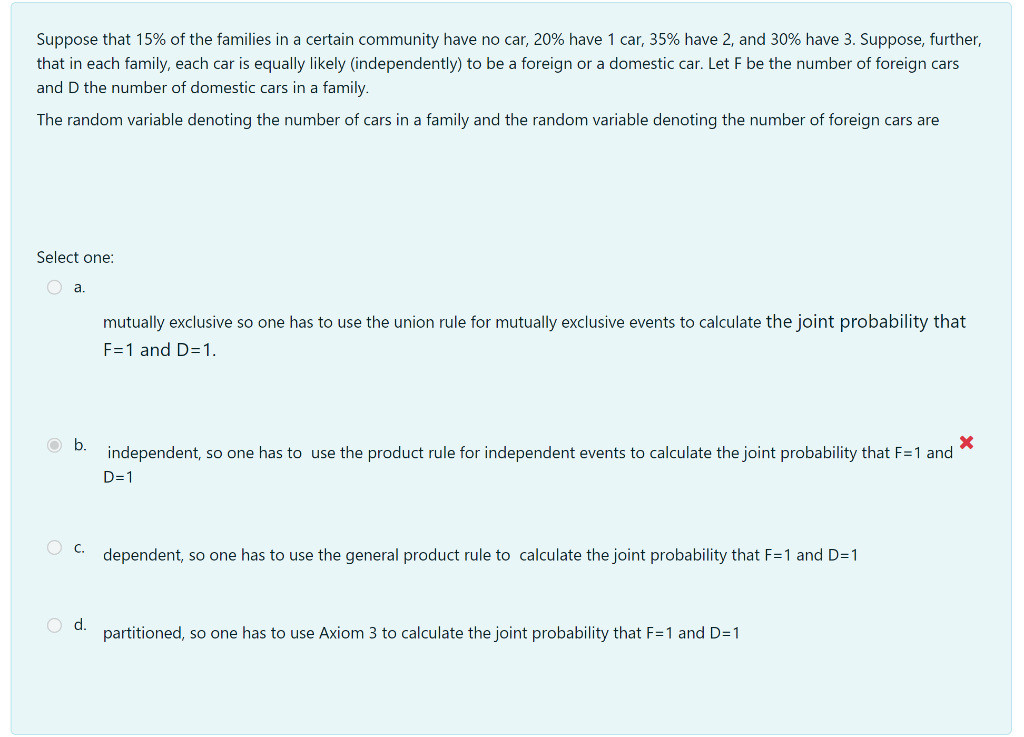suppose that 15% of the families in a certain community have no car, 20% have 1 car, 35% have 2, and 30% have 3. Suppose, furt hat in each family, each car is equally likely (independently) to be a foreign or a domestic car. Let F be the number of foreign cars nd D the number of domestic cars in a family. he random variable denoting the number of cars in a family and the random variable denoting the number of foreign cars are Eelect one: а. mutually exclusive so one has to use the union rule for mutually exclusive events to calculate the joint probability tha F=1 and D=1.
suppose that 15% of the families in a certain community have no car, 20% have 1 car, 35% have 2, and 30% have 3. Suppose, furt hat in each family, each car is equally likely (independently) to be a foreign or a domestic car. Let F be the number of foreign cars nd D the number of domestic cars in a family. he random variable denoting the number of cars in a family and the random variable denoting the number of foreign cars are Eelect one: а. mutually exclusive so one has to use the union rule for mutually exclusive events to calculate the joint probability tha F=1 and D=1.
Holt Mcdougal Larson Pre-algebra: Student Edition 2012
1st Edition
ISBN:9780547587776
Author:HOLT MCDOUGAL
Publisher:HOLT MCDOUGAL
Chapter11: Data Analysis And Probability
Section11.8: Probabilities Of Disjoint And Overlapping Events
Problem 2C
Related questions
Question

Transcribed Image Text:Suppose that 15% of the families in a certain community have no car, 20% have 1 car, 35% have 2, and 30% have 3. Suppose, further,
that in each family, each car is equally likely (independently) to be a foreign or a domestic car. Let F be the number of foreign cars
and D the number of domestic cars in a family.
The random variable denoting the number of cars in a family and the random variable denoting the number of foreign cars are
Select one:
a.
mutually exclusive so one has to use the union rule for mutually exclusive events to calculate the joint probability that
F=1 and D=1.
independent, so one has to use the product rule for independent events to calculate the joint probability that F=1 and
D=1
O C.
dependent, so one has to use the general product rule to calculate the joint probability that F=1 and D=1
O d.
partitioned, so one has to use Axiom 3 to calculate the joint probability that F=1 and D=1
Expert Solution
This question has been solved!
Explore an expertly crafted, step-by-step solution for a thorough understanding of key concepts.
This is a popular solution!
Trending now
This is a popular solution!
Step by step
Solved in 2 steps

Recommended textbooks for you

Holt Mcdougal Larson Pre-algebra: Student Edition…
Algebra
ISBN:
9780547587776
Author:
HOLT MCDOUGAL
Publisher:
HOLT MCDOUGAL


Algebra & Trigonometry with Analytic Geometry
Algebra
ISBN:
9781133382119
Author:
Swokowski
Publisher:
Cengage

Holt Mcdougal Larson Pre-algebra: Student Edition…
Algebra
ISBN:
9780547587776
Author:
HOLT MCDOUGAL
Publisher:
HOLT MCDOUGAL


Algebra & Trigonometry with Analytic Geometry
Algebra
ISBN:
9781133382119
Author:
Swokowski
Publisher:
Cengage

College Algebra
Algebra
ISBN:
9781305115545
Author:
James Stewart, Lothar Redlin, Saleem Watson
Publisher:
Cengage Learning

College Algebra (MindTap Course List)
Algebra
ISBN:
9781305652231
Author:
R. David Gustafson, Jeff Hughes
Publisher:
Cengage Learning